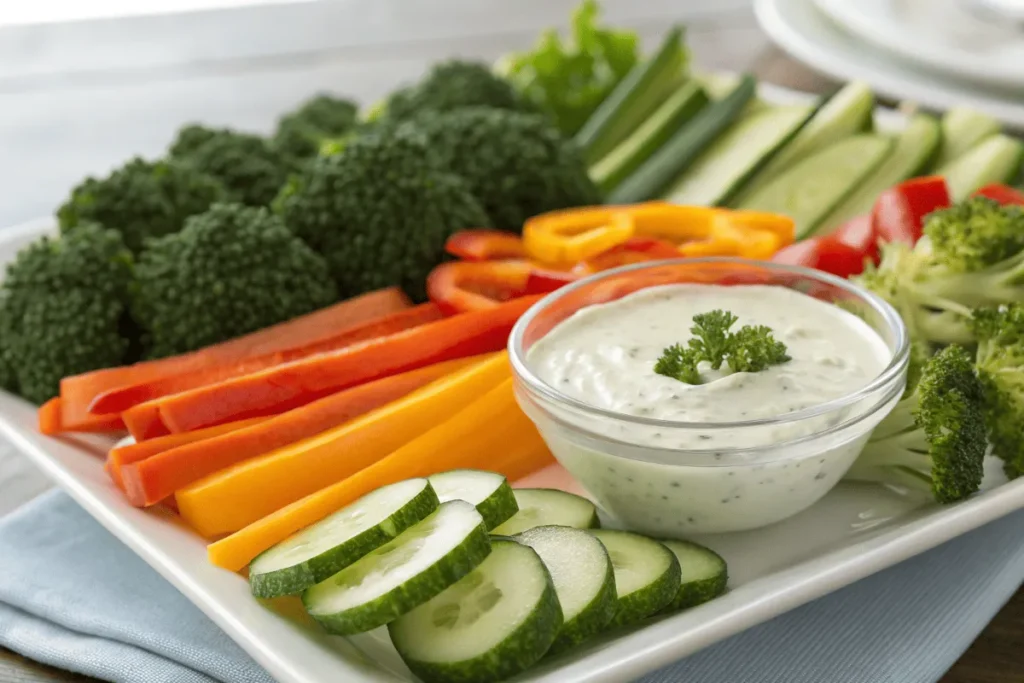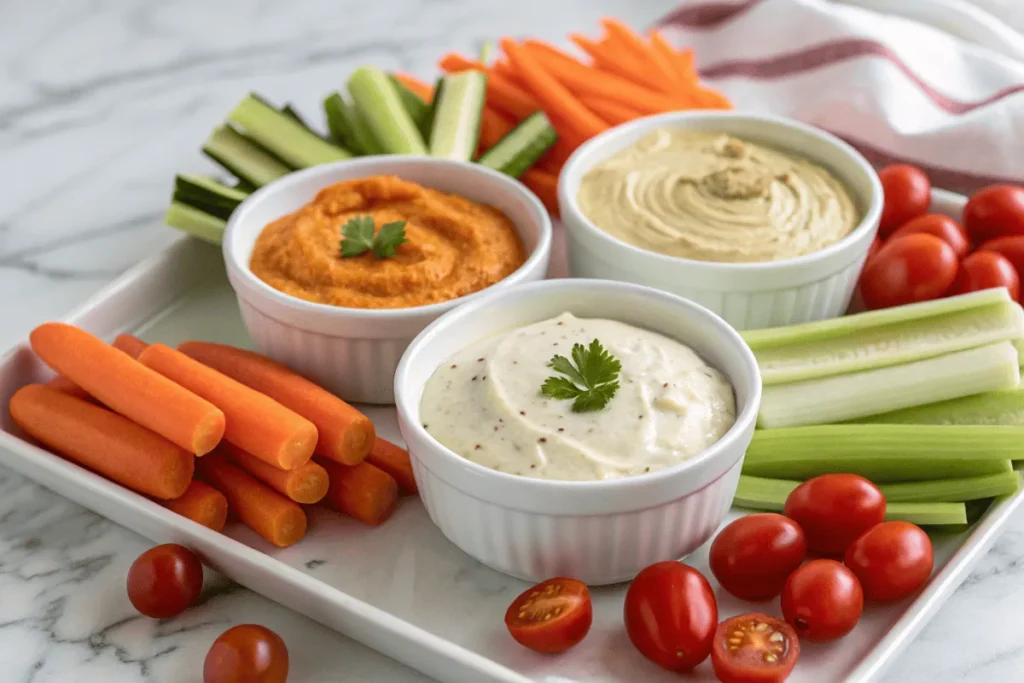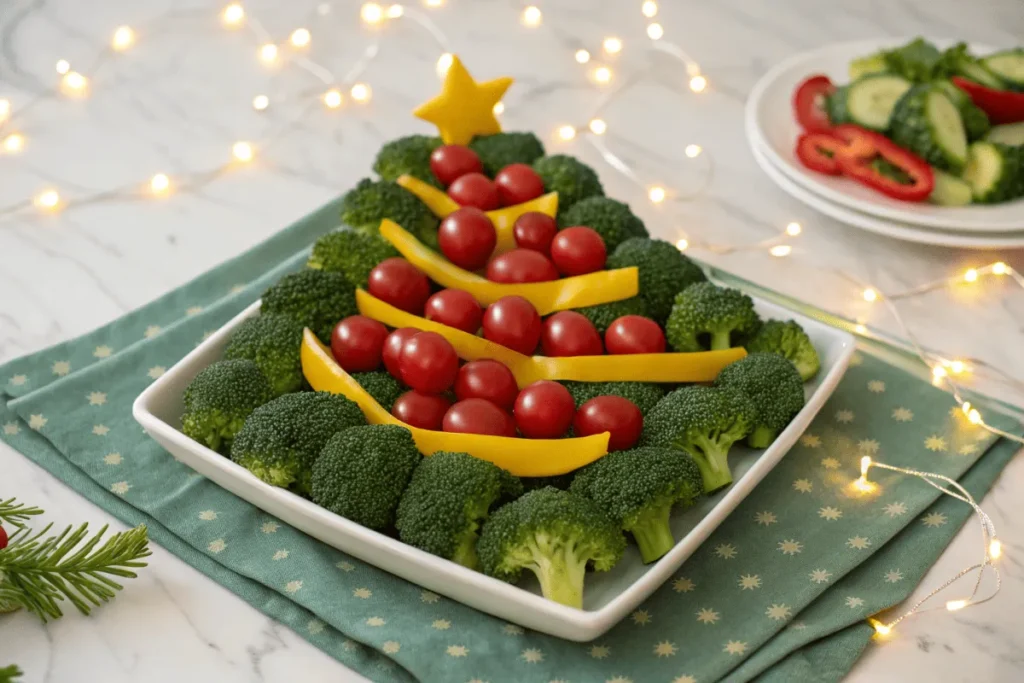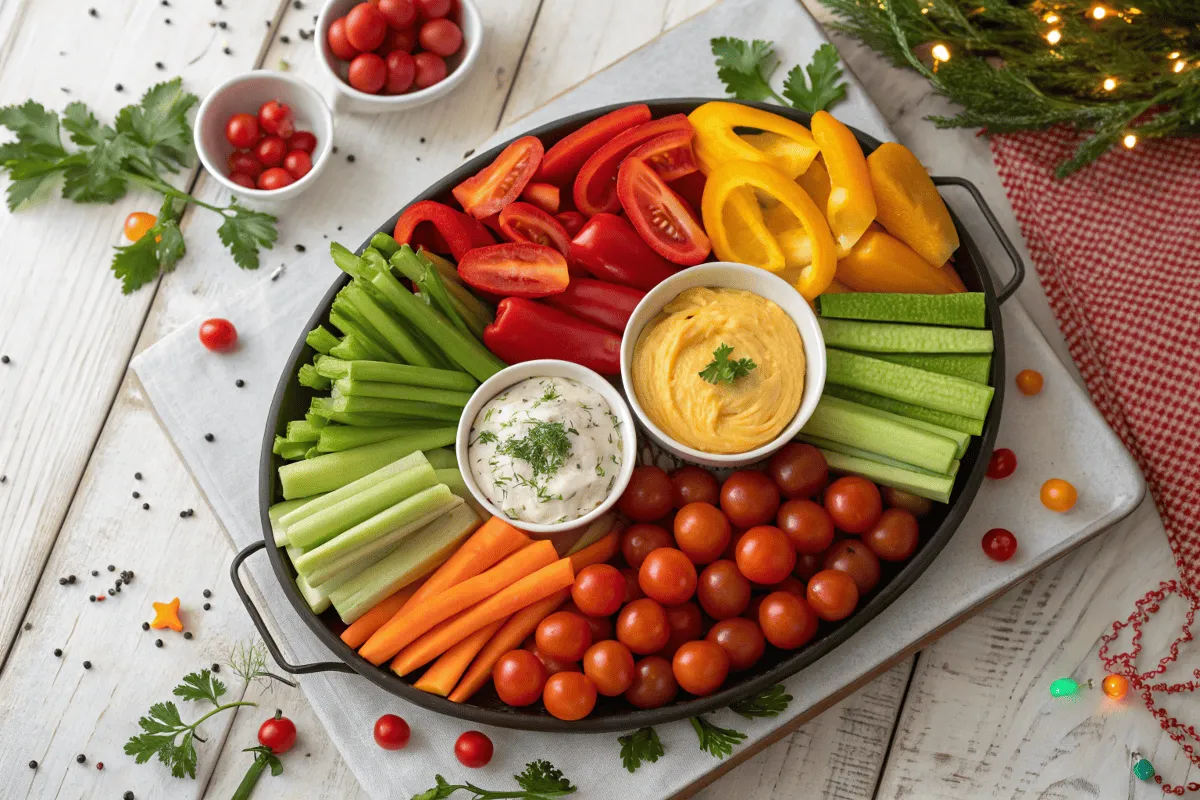Veggie trays are the unsung heroes of parties, potlucks, and family gatherings. They’re colorful, healthy, and so versatile that you can customize them for any occasion. Whether you’re hosting a big event or just want to snack smarter, a well-crafted veggie tray is a simple yet impressive addition to your menu. But what makes a veggie tray perfect? Let’s dive into the art and science of crafting one that’ll steal the show.
Introduction to Veggie Trays
What Is a Veggie Tray?

A veggie tray, often called a vegetable platter, is a collection of fresh, raw, or lightly cooked vegetables arranged beautifully and served with dips or sauces. It’s the go-to snack for health-conscious individuals and anyone who enjoys crunching on colorful, nutrient-rich foods. The beauty of a veggie tray lies in its simplicity—it requires minimal cooking, and the ingredients are as fresh as nature intended.
Why Are Veggie Trays Popular?
Veggie trays are crowd-pleasers for a reason. First, they’re healthy, offering a guilt-free snacking option packed with vitamins, minerals, and fiber. Second, they’re visually appealing, with vibrant colors and textures that look almost too good to eat. And let’s not forget the practicality—they’re quick to assemble and cater to various dietary preferences, making them ideal for almost any gathering. Plus, who doesn’t love a good dip? It’s like the cherry on top!
Health Benefits of Including Veggie Trays in Your Diet
You’ve heard it a million times—eat your veggies! But why? Vegetables are loaded with essential nutrients that boost your immune system, improve digestion, and keep your skin glowing. Snacking on a veggie tray helps curb junk food cravings while keeping you full. And because they’re low in calories but high in fiber, they’re perfect for anyone looking to maintain or lose weight.
“A veggie tray is more than just a snack—it’s a vibrant platter of health served with a side of yum!” 🌱
Essential Components of a Veggie Tray
Best Vegetables for a Veggie Tray
The star of any veggie tray is, of course, the veggies themselves. Choosing the right vegetables is crucial to creating a tray that’s not only delicious but also visually stunning.
Commonly Used Vegetables
Think of carrots, celery, cucumbers, cherry tomatoes, and bell peppers as the foundation of your tray. These classics are universally loved for their crunch and flavor.
Seasonal Options for More Variety
Seasonal vegetables like asparagus, radishes, or snap peas can elevate your veggie tray game. They add a unique twist and keep things fresh and exciting. Plus, using seasonal produce often means fresher, more flavorful vegetables.
Delicious Dips and Sauces for Your Veggie Tray

No veggie tray is complete without dips. A good dip can take simple vegetables and turn them into a gourmet snack.
Classic Dip Options
Ranch dressing, hummus, and blue cheese dips are crowd favorites. They’re creamy, flavorful, and pair beautifully with almost any vegetable.
Creative and Unique Dips to Try
Want to impress your guests? Try a roasted red pepper hummus, avocado crema, or a spicy yogurt dip. These options are not only tasty but also offer something a little different from the usual fare.
Add-ons to Elevate Your Veggie Tray
If you’re looking to make your veggie tray truly stand out, consider adding some fun extras.
Nuts, Seeds, and Crackers
A handful of roasted nuts, a sprinkle of seeds, or a few artisan crackers can add texture and variety to your tray. They also make the tray feel more like a complete snack rather than just raw veggies.
Cheese and Fruit Pairings
Adding cheese cubes or fresh fruits like grapes and berries can balance the savory flavors of the veggies and dips with a touch of sweetness. It’s all about creating a well-rounded flavor profile.
“Think of a veggie tray as a blank canvas—your vegetables are the colors, and the dips and add-ons are the brushstrokes that bring it to life!” 🎨
Step-by-Step Guide to Assembling a Veggie Tray
H3: Choosing the Right Platter or Tray
Your platter is the stage for your veggie masterpiece. A large wooden cutting board, a ceramic tray, or even a colorful plate works well. Just make sure it’s spacious enough to fit all your components while leaving room for dipping bowls.
Cutting Veggies for the Perfect Veggie Tray
Wash all vegetables thoroughly and cut them into bite-sized pieces. Carrot sticks, celery ribs, and bell pepper strips are staples, but feel free to get creative with crinkle-cut slices or fun shapes using cookie cutters.
Arranging a Stunning Veggie Tray for Guests
Start by placing dips in small bowls on the tray. Then arrange your veggies around them in groups, keeping similar colors and textures together. This creates a visually appealing pattern and makes it easier for guests to grab their favorites.
Storing and Serving Tips
If you’re prepping ahead, store your veggies in airtight containers in the fridge. To keep them crisp, wrap them in damp paper towels. Just before serving, assemble everything on your platter and keep it chilled until it’s time to serve.
🌟 Pro Tip: Drizzle a little lemon juice on cut veggies like cucumbers or apples to keep them from browning. It’s a simple trick that makes all the difference!
Creative Themes and Designs for Veggie Trays

Holiday-Themed Veggie Trays
Who says veggie trays can’t be festive? During holidays like Christmas, Thanksgiving, or Halloween, you can design your veggie tray to reflect the season. Picture a Christmas tree-shaped tray with broccoli as the base, cherry tomatoes as ornaments, and yellow bell peppers as garlands. Or a spooky Halloween platter with carved pumpkin dip bowls and veggie “fingers.” Themed trays add an element of fun and creativity to your spread.
Kid-Friendly Veggie Trays
Getting kids to eat their veggies can feel like convincing a cat to take a bath, but a kid-friendly veggie tray can work wonders. Use colorful veggies like rainbow carrots and cherry tomatoes, and arrange them into fun shapes like animals, flowers, or even smiley faces. Pair them with kid-approved dips like cheese sauce or peanut butter yogurt. Adding a sense of play turns healthy eating into an adventure for the little ones.
Minimalist or Gourmet Styles
Sometimes, less is more. A minimalist veggie tray focuses on clean lines and just a few high-quality vegetables, like heirloom carrots or perfectly sliced cucumbers. On the other hand, a gourmet tray can go all out with specialty veggies like Romanesco broccoli, microgreens, or edible flowers for a sophisticated touch.
“Whether you’re going for fun, festive, or fancy, there’s a veggie tray design for every mood and occasion!” 🎉
Common Problems When Making a Veggie Tray
Keeping Vegetables Fresh
Ever pulled out your veggie tray and found the cucumbers soggy or the carrots dry? Keeping your vegetables fresh can be tricky, especially if you’re prepping ahead of time. Exposure to air and moisture is often the culprit.
Balancing Flavors and Textures
Too much crunch and no creaminess? All sweet and no savory? A poorly balanced veggie tray can leave guests picking at it instead of devouring it. Balancing flavors (sweet, salty, tangy) and textures (crunchy, creamy, tender) is key to a satisfying tray.
Managing Dietary Restrictions
In today’s world, you’re likely to have guests with different dietary needs—vegan, gluten-free, keto, and so on. A one-size-fits-all tray might not cut it, and navigating these preferences can feel overwhelming.
Solutions to Veggie Tray Challenges
Tips for Prolonging Freshness
To keep vegetables crisp and vibrant, soak them in ice water for 15 minutes after cutting. Store them in sealed containers lined with a damp paper towel to maintain moisture without making them soggy. For dips, use airtight containers to keep them fresh and flavorful.
“Crisp veggies are the life of the party—don’t let them go limp before their time!” 🥕
Customizing Trays for Specific Needs
When managing dietary restrictions, include a variety of options. For vegans, focus on plant-based dips like hummus or guacamole. For keto guests, provide high-fat dips like ranch or blue cheese, and skip carb-heavy add-ons like crackers. Clearly label sections of the tray to avoid confusion.
Troubleshooting Dip Pairing Issues
Ever served a dip that didn’t match the veggies? The key is pairing complementary flavors. For example, creamy dips like ranch or tzatziki go well with crunchy veggies like carrots and celery, while spicy dips like harissa or sriracha hummus pair nicely with milder veggies like cucumbers and zucchini.
The Cost of Creating a Veggie Tray
Budget-Friendly Tips
Veggie trays don’t have to break the bank. Buy vegetables in bulk, stick to seasonal produce, and opt for homemade dips to save money. For example, making your own hummus is not only cheaper but also allows you to customize the flavors.
DIY vs. Store-Bought: Which Is Better?
While store-bought trays are convenient, they’re often pricier and lack the personal touch of a DIY tray. Homemade trays give you control over the ingredients, allowing you to choose fresher veggies, better dips, and a design that fits your occasion. However, if you’re short on time, a store-bought tray can be a lifesaver.
“A DIY veggie tray isn’t just a snack—it’s a statement of love, care, and creativity.” 🌟
Veggie Tray Ideas for Different Occasions
Party Veggie Trays
For a lively party atmosphere, create a bold and colorful tray. Use a mix of bright veggies like red bell peppers, yellow squash, and purple cauliflower. Add a few novelty items like pickled veggies or stuffed mini peppers to keep things interesting.
Office Lunch Veggie Trays
Office lunches are about convenience and ease. Keep your tray simple with easy-to-grab options like baby carrots, celery sticks, and cherry tomatoes. Add small cups of pre-portioned dips to make it office-friendly and reduce mess.
Veggie Trays for Outdoor Gatherings
Outdoor events call for sturdier vegetables that can withstand warmer temperatures. Stick to options like cucumbers, bell peppers, and radishes. Avoid watery veggies like zucchini or lettuce that can wilt quickly. Keep the dips chilled in a cooler for freshness.
How to Encourage Guests to Enjoy Veggie Trays
Making Veggies More Appealing
Let’s face it: some people just aren’t big fans of veggies. But with a few tweaks, you can make them irresistible. Start by offering a variety of colors and textures. Bright orange carrots, crisp green celery, and juicy cherry tomatoes are hard to ignore. Then, step up the flavor game with creative dips or seasonings. For example, sprinkle a bit of chili powder or lemon zest over your veggies to give them an extra zing.
You can also use presentation to your advantage. A neatly arranged veggie tray with symmetrical patterns or fun shapes instantly becomes more appealing. Remember, we eat with our eyes first!
Introducing New Flavors Gradually
Not everyone is adventurous when it comes to food. Instead of bombarding guests with unfamiliar vegetables, mix new options with familiar ones. For instance, pair lesser-known veggies like jicama or kohlrabi with popular ones like carrots and cucumbers. This way, guests can try something new without feeling overwhelmed.
Making Dips the Star Attraction
For some, the dips are the real reason to approach a veggie tray. Use this to your advantage by offering a range of options, from creamy ranch to spicy salsa. You could even add a fun twist with flavored hummus or guacamole topped with pomegranate seeds. When the dips are exciting, the veggies naturally follow!
Frequently Asked Questions About Veggie Trays
What Are the Best Vegetables for a Veggie Tray?
The best vegetables for a veggie tray depend on the occasion and personal preferences. Staples like carrots, celery, bell peppers, and cherry tomatoes are always a hit. For added variety, consider snap peas, radishes, or broccoli florets. Don’t be afraid to get creative—colorful heirloom veggies or pickled options can make your tray stand out.
How Far in Advance Can I Prepare a Veggie Tray?
You can prepare a veggie tray up to 24 hours in advance. Simply wash, cut, and store the vegetables in airtight containers or wrap them with plastic wrap. To keep them fresh, place a damp paper towel over the veggies. Assemble the tray just before serving to ensure it looks its best.
Are Veggie Trays Suitable for Vegan Diets?
Absolutely! Veggie trays are naturally vegan-friendly. Just be mindful of the dips—choose plant-based options like hummus, guacamole, or dairy-free ranch to ensure inclusivity for vegan guests.
Can Veggie Trays Be Frozen?
Freezing fresh vegetables for a veggie tray isn’t recommended because they lose their crunch and texture after thawing. However, you can freeze certain dips, like hummus or pesto, for later use.
Conclusion
Creating the perfect veggie tray is both an art and a science. From selecting fresh, vibrant vegetables to pairing them with mouthwatering dips, every detail matters. Whether you’re hosting a party, prepping for an office lunch, or just want a healthy snack, a veggie tray is your go-to option. The beauty of a veggie tray lies in its versatility—you can keep it simple or go all out with creative themes and gourmet touches.
So, what are you waiting for? Grab your favorite veggies, whip up some dips, and let your imagination run wild. Your perfect veggie tray awaits!

